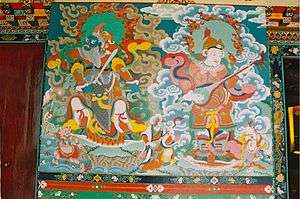Tibetology
Tibetology (Tibetan: བོད་རིག་པ་, Wylie: bod-rig-pa ) refers to the study of things related to Tibet, including its history, religion, language, politics and the collection of Tibetan articles of historical, cultural and religious significance. The last may mean a collection of Tibetan statues, shrines, Buddhist icons and holy scripts, Thanka embroideries, paintings and tapestries, jewellery, masks and other objects of fine Tibetan art and craftsmanship.
History
- The Jesuit Antonio de Andrade (1580–1634) and a few others established a small mission and church in Tsaparang (1626), in the kingdom of Guge (Western Tibet) in the 17th century. When the kingdom was overrun by the king of Ladakh (1631), the mission was destroyed.
- A century later another Jesuit, the Italian Ippolito Desideri (1684–1733) was sent to Tibet and received permission to stay in Lhasa where he spent 5 years (1716–1721) living in a Tibetan monastery, studying the language, the religion of the lamas and other Tibetan customs. He published a couple of books in Tibetan on Christian doctrine. Because of a conflict of jurisdiction (the mission was entrusted to the Capuchins, and not to the Jesuits) Desideri had to leave Tibet and returned to Italy, where he spent the rest of his life publishing his Historical notes on Tibet. They were collected, in 4 volumes, under the title of Opere Tibetane (Rome;1981–1989). Desideri may be considered as the first Tibetologist and he did much to make Tibet known in Europe.
- Desideri was however a pioneer, and as such what he produced were rather 'observations' on Tibet, a work he did with objectivity and sympathy, but not always perfect accuracy. The inception of Tibetology as an authentic academic discipline is thus associated with the Hungarian Kőrösi Csoma Sándor Alexander Csoma de Kőrös (1784–1842) who is considered as its founder to present day, the other early tibetologists of note being Philippe Édouard Foucaux who in 1842 occupied the first chair for Tibetan studies in Europe[1] and Isaac Jacob Schmidt, who was primarily the pioneering mongolist residing in Saint Petersburg.
The publications of the British diplomat Charles Alfred Bell contributed towards the establishment of tibetology as an academic discipline. As outstanding tibetologists of the 20th century the British Frederick William Thomas, David Snellgrove, Michael Aris, and Richard Keith Sprigg, the Italians Giuseppe Tucci and Luciano Petech, the Frenchmen Jacques Bacot and Rolf Alfred Stein, finally the Germans Dieter Schuh and Klaus Sagaster, may be mentioned.

Since a few decades, particularly in Anglo-Saxon countries, the study of Tibet and Tibetology open itself towards other disciplines, resulting in works with interdisciplinary approach. This has become most obvious in the regular conferences of the IATS (International Association of Tibetan Studies), held at intervals of three years in different cities all over the world. As examples of such open-minded Tibet researcher we might mention the American anthropologist Melvyn Goldstein, among others, who has done noted research and publications on lexical questions, about Tibetan nomads and the modern history of Tibet. Others are Robert Barnett, Matthew Kapstein, Elliot Sperling, Alex McKay, Geoffrey Samuel, and many more.
External links
- IATS - The International Association of Tibetan Studies
- Tibetology Network
- Tibetan & Himalayan Digital Library
Footnotes
- ↑ At the school of Oriental Studies in Paris. See:Le Calloc'h, Bernard. "Philippe-Edouard Foucaux: First Tibetan teacher in Europe." Tibet Journal 12.1 (1987): 39-49.
Literature
- Tsering Shakya: The Development of Modern Tibetan Studies. In: Robert Barnett (Hg.): Resistance and Reform in Tibet (Bloomington/Indianapolis, Indiana University Press 1994), ISBN 0-253-31131-4, S. 1–14.